

Publisher: GGC Publications Group
Editor: Bob Normand, The Golden Gringo, aka "GG"
(©Copyright 2008-2020 All Rights Reserved)
"The mission and goal of the Golden Gringo Chronicles is to provide,
in an
informative and entertaining way, insight into
living
the
Costa Rican
experience as an expat.
Here's hoping you enjoy reading the Chronicles
as much as I do writing them." - GG
1. Broken News (All the News That's Fit to Reprint): 1. Coffee Supply Another Victim of COVID?; 2. GG Completes His New Citizenship; 3. Arcos Dorados (McDonald's) Donates to Police; 4. COVID-19 Suggestions Becoming Testy; 5. Costa Rica Health Director Resigns; 6. Airport to Reopen With Limited Flights.
2. Economic Drumbeat (Costa Rica Business and Economic Happenings): 1. 50,000 Colon Bill to Disappear; 2. New Plastic Money.
3. Latin America Update (Major Events in Neighboring Countries): El Salvador: President Pushes Off Phase 2 Reopening; Nicaragua: Nicaragua Establishes Protocol, Nicaragua Charges for COVID-19 Testing, Nicaragua to Head Regional Council of Health Ministers; Nicaraguans Stranded at Costa Rican Border; Panama: Permanent Closing of 1,000+ Restaurants Expected Due to Virus.
4. Rumble and Weather Talk: 1. Storm Friday July 3 Blows by; 2. Very little on the rumbling front.
5. Feature 1: Legend of the Rualdo (How the Bird Lost Its Song)
6. ¿Que Es Eso? Department: Just Another Turtle?
7. Feature 2: The Coffee Story: Part 2 - Coffee as Business
8. Health Stuff: a. The Spike and Top 7 Infected Zones in Costa Rica; b. Ford Medical Endorsement for HCQ (Hydroxychloroquine); c. Another Early Treatment Drug (Inteferon Beta); d. Yet Another Early Treatment Drug (Equine Antibodies).
9. GGC Bookshelf and More: 1. Books from GGC Publications; 2. Golden Gringo T-Shirts and Coffee Mugs; 3. Books from the Quepos-Manuel Antonio and Other Writers Groups.
10. What's-in-a-Word: a. Answer to ¿Que Es Eso?, b. Arabica versus Robusta.
11. ROMEO Corner: Gabriella's, Quepos Marina
Wisdom of the Ages

HOLIDAY WATCH
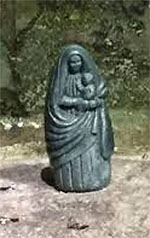 THERE IS A (PAID) HOLIDAY IN COSTA RICA IN AUGUST: Virgin of Los Angeles - August 2 (to be celebrated on Monday, August 3 in accordance with the new law to celebrate all holidays on Mondays). Once a year, the most enormous parade in Costa Rica, called the Romeria, culminates at the Basílica de Nuestra Señora de Los Ángeles in Cartago. Estimates for the 2019 procession ran as high as two million people. The procession has a history going back 385 years (1635).
THERE IS A (PAID) HOLIDAY IN COSTA RICA IN AUGUST: Virgin of Los Angeles - August 2 (to be celebrated on Monday, August 3 in accordance with the new law to celebrate all holidays on Mondays). Once a year, the most enormous parade in Costa Rica, called the Romeria, culminates at the Basílica de Nuestra Señora de Los Ángeles in Cartago. Estimates for the 2019 procession ran as high as two million people. The procession has a history going back 385 years (1635).
For only the second time in that long record the Catholic Church has called off the Romeria this year due to the COVID-19 pandemic. The first time it was canceled was in 2009 because of the H1N1 (swine) flu virus.
To read more about the story of this statue go HERE.
Coffee Supply Another Victim of COVID?
OK now, this damned COVID virus is getting out of hand; especially when it threatens our coffee supply. Coffee farmers recently warned that, due to the travel and border restrictions in place, there may not be enough transient labor to carry out the Costa Rica harvest.
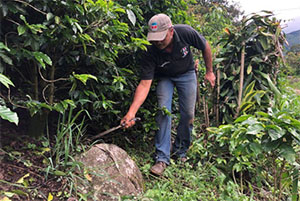 |
|---|
| A Nicaraguan Worker Weeding Coffee in the Dota Region of Costa Rica |
The typical harvest is carried out from October to March and some two-thirds of the laborers come from Panama and Nicaragua. Panama has had a tougher time controlling the virus. Total Cases in Panama as of July 30 were 62,223, 15,176 per million population and deaths at 1,349 or 329 per million; versus Costa Rica at Total Cases: 16,800 or 3,360 per million and deaths at 133, or 26.6 per million.
Unfortunately, because of the official policy of the Nicaraguan government to ignore the virus as "atypical pneumonia", the situation there is believed to be even worse according to private organizations in the country. And there is good evidence that border leakages from the north have been one of the major reasons for the current spike in cases being experienced here in Costa Rica all the way down from the border regions to the Central Valley.
Let's hope we get this virus under control soon.
GG Completes His New Citizenship
Finally got 'er all done. Last month, in the GG University article about getting citizenship in Costa Rica GG left two things incomplete: 1) inability to get my Costa Rica driver's license renewed locally because of the change in my new citizen cédula number and 2) waiting on a new Costa Rican passport; the passport of course is an elective thing not a requirement.
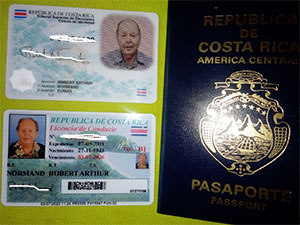 |
|---|
| Got 'em All: Cédula (top left), Driver's License (bottom left) and Passport |
Cosevi is part of the department of motor vehicles (MOPT - Ministerio de Obras Publicas y Transportes - love those Costa Rican acronyms) and handles drivers licenses as well as car registrations and inspections. A trip to Puntarenas with some friends on July 3 offered the opportunity to meet with the Cosevi office there and change my cédula number in their official records. Once that was accomplished I could renew my license and receive the new card on the spot, which I did.
I had applied for a Costa Rican passport, based on my new cédula, the previous month and was promised it in the mail for Friday July 3rd, the same day of the trip to Puntarenas. When I checked at the post office the following Monday it was there, delivered on schedule. That completes my re-identification process to being a Tico as well as a Gringo (or, if you prefer, a Gringo-Tico) - Que Bueno!
Arcos Dorados (McDonald's) Donates to Police
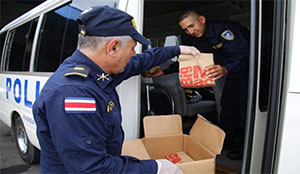 |
|---|
| Let's See José, Did You Have the Double Cheeseburger or the Big Mac? |
A recent press report noted that Arcos Dorado, the Latin American franchisee for McDonald's, was supplying some 20,000,000 colons (about $350,000) in food materials to the Costa Rican police during the COVID crisis in appreciation of their efforts. That's a lot of Big Macs (photo) in any language.
McDonald's opened it's first store outside North America in Costa Rica in 1971. After that, Arcos Dorado (Spanish for "Golden Arches") became the franchisee for all of Latin America. It now has some 2,100 stores in 20 countries including 55 McDonald's in Costa Rica and is reputed to be the largest McDonald's franchisee in the world. To read more about Arcos Dorados, go HERE.
As an American I couldn't help but contrast Arcos Dorado's empathy towards the police here with what's going on in the States at the moment. Buen trabajo amigos.
COVID-19 Suggestions Becoming Testy
We are approaching the fifth month (first reported case of COVID in Costa Rica was March 5) of living with various restrictions on our movement and behavior. However, since June 1 we have seen a marked spike in total cases from about 1,000 on May 30 to almost 17,000 on July 30. Just about every aspect of news has been dominated by the pandemic. So it is unpleasant but natural that people are more on edge than they used to be and recent reports are that public figures are beginning to express their frustration.
Take these two situations for example:
The Mayor and the Alert Color
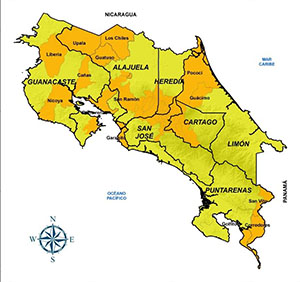 Costa Rica uses a system of colors to designate different "alerts" for various threats. Currently, parts of Costa Rica (pretty much all of it) have been designated as being on "yellow" alert for COVID-19 while the more troublesome areas are designated as "orange" alerts (image left). Green alerts are not an indication of safety; they are used in conjunction with storms and heavy rain. If there are other colored alerts, GG doesn't know about them.
Costa Rica uses a system of colors to designate different "alerts" for various threats. Currently, parts of Costa Rica (pretty much all of it) have been designated as being on "yellow" alert for COVID-19 while the more troublesome areas are designated as "orange" alerts (image left). Green alerts are not an indication of safety; they are used in conjunction with storms and heavy rain. If there are other colored alerts, GG doesn't know about them.
Recently the Health Ministry issued a revaluation of the ratings by area (Canton or County) and the canton north of us, Garabito, which includes Jacó was kept at orange status. This prompted the mayor of Garabito to get vocal. Mayors here are, in essence, mayors of counties rather than towns or cities, unless the region they represent happens to be one and the same. Said the mayor of Garabito: "What do they want? Lead us to ruin, lead us to bankruptcy? We were the first canton to close the beaches and we are also going to be the first canton to rise up,"
Reports have it that just seven hours after the mayor complained to both the Ministry and the press, the status in Garabito was changed to yellow, like Quepos. Now all the Pacific coast from southern Guanacaste down to the OSA is yellow once more. That doesn't mean we can use the beach normally, it remains restricted to 5 am to 9 am but I presume Garabito can now do the same whereas they had to be perpetually closed before.
Bishop Verbally Challenges His Flock
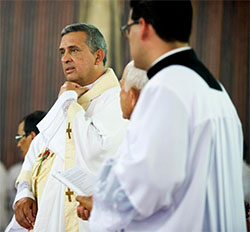 |
|---|
| The Bishop at Work. |
Meanwhile, Manuel Eugenio Salazar, the Bishop of Tilarán (northwest of San Jose, not far from Liberia, and in an orange alert zone) had some strong words for his flock.
Talking about the number of gatherings that include parties and family reunions, all without proper health cautions, the bishop first warned his people that he was about to get basic in his preaching and then said: “If you want to die, die, you are at liberty. I don’t want you to die, but if you want to die, die, but you don’t have the right to kill others, to go to the grave taking with you a lot more people, that is why we have to respect hygiene measures, respect the measures of the Ministry of Health.”
He went on to talk about his own discomfort in not being able to go out and do the things he normally does and pleaded (more like demanded) patience. Now that's getting down to the basic message; bravo Padre.
Costa Rica Health Director Resigns
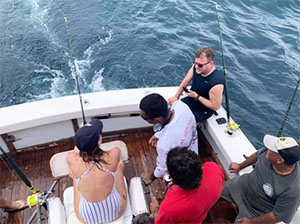 |
|---|
| Rod and His Friends Fishing |
Until the third week in July, Costa Rica had a Director of Surveillance in its health ministry reporting to the Director of the Ministry. GG is not sure what the specific duties of the DOS are but the name would imply something to do with making sure the population is honoring the rules, regulations and laws related to any pandemic crisis.
Unfortunately for one Dr. Rodrigo Marín, the DOS on Sunday, July 19th was caught on film the same day enjoying a fishing trip off Guanacaste with friends. He was using no protective equipment nor practicing social distancing (photo - Marín is sitting on the corner of the transom). In his resignation letter the next day he said: "I was wrong, I did not keep the distance outside my bubble and I did not use personal protective equipment." Caio, amigo.
Que era atroz, amigo. (That was egregious; and egregious sounds better in Spanish)
Airport to Reopen to Limited Flights
On July 23rd the government announced that effective August 1 the main airport at San Jose, Juan Santamaria, will be reopened to flights, but only from Canada, the European Union and the United Kingdom. The U.S. was notably absent from the list. ??? Overall, the U.S. Covid numbers are no worse than some countries in Europe (UK, Spain, Italy).
Wazzaaaaatabout amigos (I'm starting to feel like the Mayor of Garabito)? What actually is going to happen in the next week seems more a matter of confusion than an easily comprehended policy. As they say here; "Vamos a ver." (We'll see.)
¡Pura Vida!
50,000 Colon Bill to Disappear
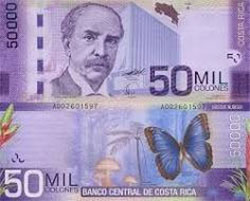 |
|---|
| The 50 Mil Colon Bill |
About ten years ago the Costa Rican government decided to overhaul their currency system including bills of 1,000, 2,000, 5,000 and 10,000 colons. At that time the exchange rate was running 500 colons to the dollar making equivalence calculations easy: just multiply the colons by 2 and take away three zeros (500 x 2 = 1,000 = $1). At the same time, the government added new, larger denomination bills of 20,000 ($40) and 50,000 ($100). Now, at an exchange rate of 580 to the dollar equivalence calculations are not as easy (bring your calculator).
GG guesses the idea of the big bills was to make larger cash transactions easier. Over the ensuing years the 20,000 bill slowly came into use. The fifty (each now worth about $85 at the current exchange rate) never took hold and seeing them in circulation was a rare thing. GG guesses that the vast majority of cash transactions just don't rise to needing a fifty mil note at this time; those transactions are better handled by 10 and 20 thousand notes or credit/debit cards or by an antiquated check if they're too large. In any event the government recently announced that the 50 mil note is being removed from circulation posthaste.
The gentleman on the 50 mil note is Romualdo Ricardo Jiménez Oreamuno, President of Costa Rica for three separate four year terms between 1910 and 1936. He took office in 1910 shortly before the country went through it's worst casualty earthquake ever, which occurred in Cartago, the largest city in Costa Rica at the time. The city was virtually destroyed and over 700 killed. Jiménez was instrumental in changing the law to abandon adobe-type construction practices and use modern, earthquake resistant construction standards in their place.
Methinks that the Señor Jiménez note with the morpho butterfly on the back will return sometime in the future when cash transactions grow in value.
New Plastic Money
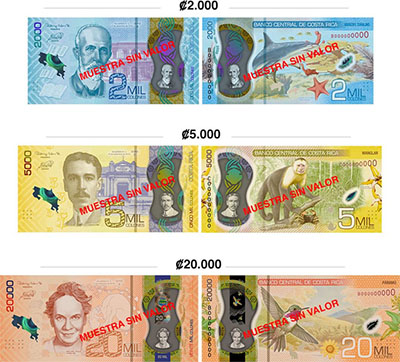 |
|---|
| The New Plastic Colon Bills |
Not long after the demise of the 50k colon note was announced, the Central Bank also announced that the other denominations of banknotes, i.e., 2,000; 5,000; 10,000 and 20,000 colon bills will be converted to a polymeric (that's an uptown word for plastic) material much like the current 1,000 note. The new bills, except for their material of construction and the addition of a couple of structural things to enhance security, will look a lot like the old bills.
GG remembers when the 1,000 plastic note was first issued and the problems people had using it - very slippery, difficult to stack, sometimes it seemed like they even jumped out of your hand or wallet. Eventually we got used to them, especially when the surface got dirtier and roughened a bit to make then easier to handle.
Sounds like we have some more slipping and sliding coming. No date has been set for the change over as machines such as ATM's will all need to be re-calibrated to handle the new materials (wouldn't want the machine to give out five 20k bills when it should have given out only two - well at least the bank wouldn't want that).
¡Pura Vida!
El Salvador
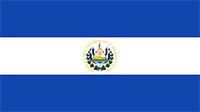 Near the end of July, President Nayib Bukele announced that plans to enter Phase 2 of the reopening of the country will be postponed. As of July 28 El Salvador had registered a total of 15,446 coronavirus cases and 417 deaths. No new date was projected for the start of Phase 2.
Near the end of July, President Nayib Bukele announced that plans to enter Phase 2 of the reopening of the country will be postponed. As of July 28 El Salvador had registered a total of 15,446 coronavirus cases and 417 deaths. No new date was projected for the start of Phase 2.
Nicaragua

Nicaragua Establishes Protocol. After more than three months of officially denying the presence of COVID-19 in the country, calling it "atypical pneumonia", and establishing no testing routine or control procedures, Nicaragua recently established a policy for repatriated Nicaraguans and foreign travelers.
All travelers requesting entry will be required to provide the results of a COVID-19 test done within 72 hours before their arrival (U.A.E. has started testing all their boarding passengers; it's likely others will follow). If an arriving non-national gets a positive result, they will be refused entry. A positive national will be home-quarantined "according to protocols" (of which none were defined in the government's message).
By July 1 there were literally thousands of Nicaraguans stranded about the globe. July saw an agreement to allow some 1,180 Nicaraguans in Panama to repatriate only to be bogged down in disagreements between the two countries. Finally, in mid-July, some 274 were repatriated from Panama and another 174 from Barbados who were part of Royal Caribbean crews assigned to various cruise ships.
Nicaragua Charges for COVID-19 Testing. In the midst of all this the press also disclosed that Nicaragua is the only country in Central America that charges for a COVID-19 test in public hospitals. It will cost you US$150 to get a widely-used PCR (polymerase chain reaction) test, the most widely used test for COVID. In public hospitals in Costa Rica this test is free; in private hospitals in Honduras, Panama, and Costa Rica the test would cost you US$44 to US$95.
Nicaragua to Head Regional Council of Health Ministers. July saw Nicaragua assume the Pro Temporary Presidency of the Council of Ministers of Health of Central America and the Dominican Republic (COMISCA). Despite objections by many inside and outside of the Council, including the previous president of the council, and despite Nicaragua's action regarding the Coronavirus, the changeover happened as scheduled.
The function of the regional council is to develop and implement a coordinated regional health plan. It was pointed out that Nicaragua already was acting contradictory (that's polite Spanish for being in violation) to the existing plan when it came to handling the pandemic.
The Presidency Pro-Temporary term is for six months.
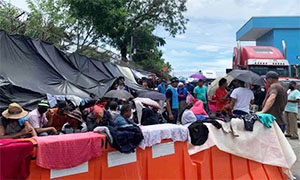 |
|---|
| 500+ Nicaraguans Caught at Border |
Nicaraguans Stranded at Costa Rican Border. On Tuesday, July 22, Nicaragua changed their border regulations for entry (mentioned above), even for citizens, to include a valid, negative COVID-19 test result to allow entry. Since then returning Nicaraguans have been caught by this new requirement. By the end of July over 600 Nicaraguans had amassed at the Peñas Blancas border crossing in northwest Costa Rica. They have been granted exit from Costa Rica but Nicaragua will not let them in without a negative COVID-19 test.
Instead of granting them entry and having them quarantined and tested in their home country, they have been refused entry by their home country. So they are caught in a kind of "no-man's land" between the borders. I guess Nicaragua expects Costa Rica to provide the testing (what was that about it taking a week?). It sounds like a worsening, volatile situation that could easily get out of control. Vamos a ver amigos (we're going to see).
Panama
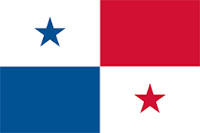 The Panama Restaurant Association (Arap) stated that, as a result of the Pandemic, Panama has experienced an 80% drop in restaurant sales and what is likely to be a 20% permanent closure of restaurants. Than amounts to at least 1,000 restaurants.
The Panama Restaurant Association (Arap) stated that, as a result of the Pandemic, Panama has experienced an 80% drop in restaurant sales and what is likely to be a 20% permanent closure of restaurants. Than amounts to at least 1,000 restaurants.
As of July 28, some 61,442 cases of COVID-19 and 1,322 deaths have been registered as a result of the pandemic in Panama.
¡Pura Vida!
Weather
A strong tropical storm swept into Costa Rica on July 3 but GG was lax in gathering the info and it swept out again in a day to a day and a half. Afternoon and evening rains, sometimes heavy, continued through July into August. The rainy season is here, no doubt about it; the nights are so cool as to require some kind of covering (in GG's case, a sheet - bootiful sleeping weather).
Shakers
Nothing significant this month. a few tremors in the range of low 5.+ occurred in the countries north and south of us but nothing significant to report about Costa Rica (gracias a Dios).
¡Solo Bueno!
Check Out Recent Earthquakes Around the World Posted by the U.S. Geodetic Survey: Recent Quakes |
Search the Golden Gringo Chronicles Archives for Topics That Interest You
You can use our Archives to search for anything that has been written in more than 260 feature articles of the Golden Gringo Chronicles plus find Broken News items and ROMEO restaurant reviews. Enter your topic or item to search in the Google Search Routine below and follow the links offered from the search results. Suggestion: Enter only a simple, precise and unique as possible keyword or
two in order to narrow the number of references retrieved:
Readers: Our publication is open to suggestions regarding future articles and will accept pieces written by others but we reserve the right to decline anything that the editorial staff (that's GG) thinks is inappropriate for this format. Send proposals, comments, suggestions, ideas, meaningless statements and jocular observations concerning the Chronicles to GG here: gg@goldengringo.com.
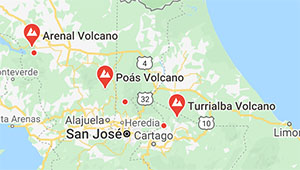 |
|---|
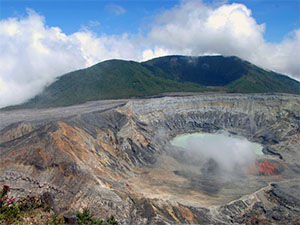 |
| Volcan Poas |
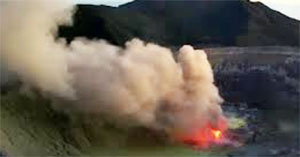 |
| Poas Erupting |
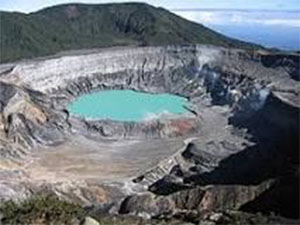 |
| Botos Lagoon at Volcan Poas |
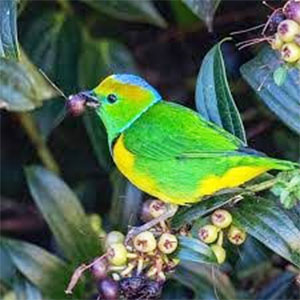 |
| A Rualdo (Chlorophonia Callophrys) |
The story takes place in the region of Volcan Poas, one of our volcanoes that is still periodically active.
The volcano is only about 30 km north of the capital city of San José on the edge of the central valley and in the middle of the Cordillera Central, the central spine of mountains that bisects Costa Rica. It can also be thought of as part of the eastern end of the highly volcanic and active Pacific Rim.
The site is now a National Park which can be visited by tourists (these days you must check wherever you go for current opening hours). This area, like most of Costa Rica, is accentuated by a lush green rainforest and a plethora of beautiful birds and butterflies of every color and stripe.
There is no date associated with the Legend of the rualdo but it is assumed to be pre-Colombian (prior to 1500). Recall that natives often related natural wonders to the gods and that a volcano spewing lava and poisonous gases was thought of as an angry god.
The legend goes this way:
A native tribe lived near the volcano and included a beautiful young girl named Ileana whose father was the shaman of the tribe. With the natural beauty of this area being what it was for a long time it seemed that the great God above (often referred to as Sibo) had smiled on this mountain and made it a home for the tribe; at least that was what Ileana believed. But her father had heard stories of the wrath of Poas in which it spewed forth fire and lava which could destroy many of the living things around the volcano. Ileana never experienced that part of Poas and she had no interest in these stories.
At some point Ileana befriended a rualdo bird, which then had very plain, brown plumage but with a beautiful singing voice. Whenever Ileana felt needy, fearful or sorrowful the splendid voice of this bird would lift up her spirits. The bird followed her everywhere and they became close friends. Ileana loved this bird and it returned its love in kind particularly because she had once saved its life.
Then one day the volcano began rumbling and shaking and continued to do so for some days. The shaman feared the worse and that his village might be destroyed. Finally, he decided to march up the side of the funnel to the top and ask the spirit of the volcano how he could satisfy it so his people would not be hurt. The answer stunned the shaman as the spirit told him the only thing that could satisfy his anger would be for the shaman to sacrifice his daughter to him. The shaman agonized a bit but then agreed to save his people and village.
After returning to the village, the shaman put Ileana in custody and dragged her bound, kicking and screaming to the top of the mountain. Then he screamed and was ready to throw her into the pit. Instead, the rualdo was there and plunged into the heart of the crater at the same time and, by loud song, pleaded for the life of Ileana in exchange for him giving up his ability to sing. As he sang the rumbling quieted and Ileana, as well as the village, was saved. It is said that, as the rualdo sang about friendship and faithfulness and of the beauty of his native land, the rumbling ceased. Although he was required to give up his song, he was allowed to keep new, beautiful plumage (above).
It is also said that: "The beauty of the rualdo bird's song made the volcano weep, flooding the crater that is known today as the Botos Lagoon".
IN the Legend of the Rualdo we have another story of the mystery and spirituality of Costa Rica. If you'd like to read about other legends of mystery in Costa Rica, there are at least two of my books you might enjoy: Mariposa, A Love Story of Costa Rica and Las Esferas, Mystery Spheres of Costa Rica.
¡Pura Vida!
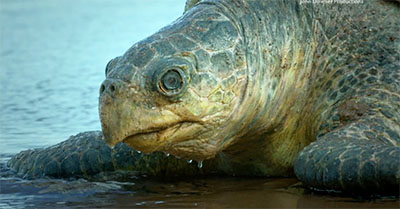
Just another turtle, right?
What's different about this turtle? Every year thousands of turtles like her descend on numerous islands and beaches of Costa Rica, particularly on the Caribbean side and lay their eggs (sometimes 100+ to a clutch).
What kind of eggs might this one lay?
Hint: The secret is in her eyes.
Answer in What's-in-a-Word section below.
¡Pura Vida!
 |
|---|
| Coffee and Chocolate - Perfect! |
Last month the Chronicles began a series of three articles on coffee based on a YouTube series suggested by a friend of the Chronicles.
Last month was Part 1 and it covered the history and growth of coffee as a favorite beverage since its beginning long ago in Ethiopia. This month, Part 2, we look at the business of coffee and the effect it has had upon the world.
Current consumption of coffee is estimated at 500 billion cups per year worldwide. That's about 65 cups per capita for every per capita in the world including those per capitas that don't imbibe java.
You may remember, as pointed out in Part 1, that the commercial trading of coffee represents the second greatest commodity value in the world after oil. That value of coffee is over $100 billion annually and includes a total export value of at least $20 billion. This is not small business. The table below shows the current top 10 producers of coffee by country (I added little Costa Rica's position at #15 as a comparison to some of the big boys).
 |
|---|
| Coffee Production by Country 2019 - Note That Half the Top Producers Are Latin American Countries: Brazil, Colombia, Honduras, Mexico and Guatemala |
The 1700's proved to be pivotal in the development of the coffee business, Accompanying coffee's growth were events historical and colorful, an example of the latter being the story of how coffee first got to Brazil.
At the time, nearby French Guiana had begun producing coffee but the Governor there would not share the seeds or plants with Brazil. So the Brazilian envoy to French Guiana managed to seduce the wife of the Governor of French Guiana and, as he departed to return home, the lady presented him with a rose bouquet in which there were, hidden in the petals, seeds of a coffee plant. Ah, toujour l'amour. Before long Brazil became a major producer of coffee and it still is numero uno (see the table above).
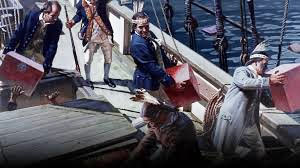 |
|---|
| Boston Tea Party - 1773 |
Other happenings caused the demand for coffee to increase; a notable one being the Boston Tea Party in December 1773. Tea imports were associated with the British at a time when a whole array of new and burdensome taxes (Stamp Act) were imposed on the colonies. The rebels complaint quickly became an angry "No taxation without representation!". Throwing 342 cases of tea (estimated value in today's dollars - $1.7 million) into Boston harbor to protest British taxes did not enhance the consumption of tea but it did strengthen coffee as an alternative. Three years later the Colonists were in full warring rebellion against Britain and tea was socially verboten in the colonies while coffee was being imported from Latin America tax free and at bargain prices. Tea would never again be preeminent over coffee, the latter becoming the beverage of choice in the colonies then and now.
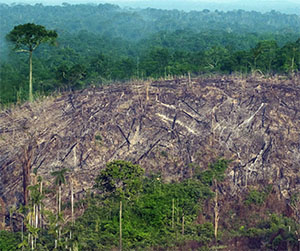 |
|---|
| A Slash and Burn Operation |
In the 1700's and into the 1800's there were cycles of boom and bust in the coffee market (I'm told there still are). The growing popularity of coffee gave rise to larger and larger plantations. While the rainforest weather pattern was perfect for growing coffee, it meant that huge tracks of land of virgin forest became subject to slash and burn deforestation to accommodate new plantations. That combined with ever increasing amounts of high quality lumber taken from these areas did much damage to the Amazon ecological system. Eventually, in modern times, severe restrictions had to be placed on both lumbering and new coffee plantations to save what was left of the Amazon rainforest.
It is estimated that in the last two hundred years almost 90% of the rainforest, an area half the size of Europe, was lost to deforestation.
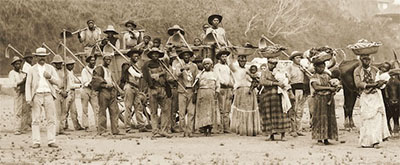 |
|---|
| Coffee Plantation Slaves in Vale do Paraiba, Brazil c. 1885 |
The strong growth in the 1700's and 1800's gave rise to the "Coffee Barons", entrepreneurs from various places, often Europe, that saw an opportunity to make money in Brazil and other coffee producing countries. They strove for success becoming wealthy and forming an upper class unto themselves by running huge plantations.
They were able to hire natives as cheap labor but eventually they needed even more cheap labor to fuel their expanding plantations so they imported slaves from Africa. It is estimated that 40% of all the slaves imported to the Americas went to Brazil during that period. Much of the coffee plantation activity was not only approved but also sanctioned and encouraged by European Royalty before these territories became independent states. While owners became rich, slaves were tortured, even killed, with impunity and with no retribution nor regulation by the government.
The slave population in Brazil grew until fully one third of the total population were slaves and half of those were on coffee plantations. Brazil was the last country in the western hemisphere to abolish slavery. They did so on May 13, 1888, 25 years after the Emancipation Proclamation in the United States.
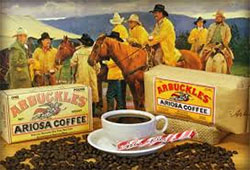 |
|---|
| "The Coffee That Won The West" |
All the way up to the mid-19th century coffee continued to be roasted by the drinker either in frying pans or on wood stoves. Then, in the U.S. a fellow named Charles Arbuckle got an idea - he'd roast the ripe beans himself, grind them and package the grind into brown paper bags. The commercial coffee market as we know it today was born. This was a product that cowboys could buy at the local general store and carry with them. Arbuckle's quickly became "The coffee that won the West." Arbuckle's is still available as specialties (flavored) from their corporate location in Tuczon, AZ HERE.
Another saying among the early cowboys was that the coffee should be made "strong enough to float a horseshoe" (yeah, baby).
The California Gold Rush of 1848-1855 stimulated a fellow from Nantucket named Jim Folger, who designed his own commercial sized roaster. He focused on shipping and supplying the miners. In the late 1800's a large variety of commercial roasting systems were created by people with various names that would become historical. Arbuckle designed his own roaster to keep his business growing. On a visit to Nashville, President Teddy Roosevelt was encouraged to try a cup of local coffee at a hotel-restaurant called Maxwell House; his reaction: "Good to the last drop!" and "Bully".
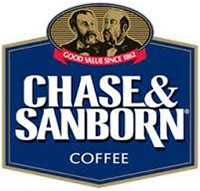 In the entrepreneurial spirit of the times all sorts of roaster designs were invented. Marketing became important and no one practiced it better than a couple of fellows named Caleb Chase and James Sanborn. These were heady times and they all thought it would never end but reality set in in the 1880's. Coffee production had significantly outpaced demand and prices plummeted. By the 1920's the market for coffee had recovered somewhat only to be beset by another slowdown in demand just in time for the Great Depression. The coffee market crashed a few weeks before the equities market.
In the entrepreneurial spirit of the times all sorts of roaster designs were invented. Marketing became important and no one practiced it better than a couple of fellows named Caleb Chase and James Sanborn. These were heady times and they all thought it would never end but reality set in in the 1880's. Coffee production had significantly outpaced demand and prices plummeted. By the 1920's the market for coffee had recovered somewhat only to be beset by another slowdown in demand just in time for the Great Depression. The coffee market crashed a few weeks before the equities market.
 In the 1930's and '40's growth in demand and supply was stimulated by large marketing firms like the Great Atlantic and Pacific Tea Company (A&P) with their in-house brands ("Eight-O'Clock", "Red Circle", "Bokar") and they could offer thousands of retail supermarket outlets. An aside: GG worked in two different A&P's (Newburyport and Lowell, Mass.) in the late 1950's and early 1960's in high school and early college. I worked my way up to the best part-time hourly rate they had ($2.35 an hour)! It was all about coffee, tea was in a remote shelf located somewhere in the center of the store.
In the 1930's and '40's growth in demand and supply was stimulated by large marketing firms like the Great Atlantic and Pacific Tea Company (A&P) with their in-house brands ("Eight-O'Clock", "Red Circle", "Bokar") and they could offer thousands of retail supermarket outlets. An aside: GG worked in two different A&P's (Newburyport and Lowell, Mass.) in the late 1950's and early 1960's in high school and early college. I worked my way up to the best part-time hourly rate they had ($2.35 an hour)! It was all about coffee, tea was in a remote shelf located somewhere in the center of the store.
 I can still smell the combination of baked goods, freshly ground coffee and huge wheels of New York State cheddar cheese that greeted a shopper as they walked into the first aisle. I would often work the grinder, as that was a service provided to the shopper, and from there I could pick at the cheese!. Mmmmm... A&P were smart marketers as they got you hungry on the first pass through the aisles (bread, coffee, cheese). They knew that hungry shoppers in a food store buy more food.
I can still smell the combination of baked goods, freshly ground coffee and huge wheels of New York State cheddar cheese that greeted a shopper as they walked into the first aisle. I would often work the grinder, as that was a service provided to the shopper, and from there I could pick at the cheese!. Mmmmm... A&P were smart marketers as they got you hungry on the first pass through the aisles (bread, coffee, cheese). They knew that hungry shoppers in a food store buy more food.
In those days coffee was often sung about, like by the Ink Spots (anybody remember them from the 1930/40's?): I love Coffee, I love Tea (Java Jive).
Good coffee was one of the things in high esteem and demand among the troops wherever they fought in World War II (1941-45). In the early part of the war the military ran a study that showed coffee to be the most effective treatment for keeping the troops alert (I could of told them that). Consequently, the U.S. Government Office of Strategic Services (OSS) underwrote the entire Brazilian coffee output from 1941 to 1943.
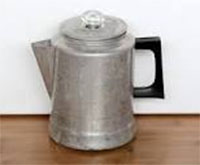 After the war major producers took to diluting the grinds with more and more partially roasted green coffee beans satisfying the aggregate demand but lowering the quality of the coffee that resulted. These grinds, when prepared in a percolator, produced a beverage higher in bitterness than most. Growing up, I remember the percolator on the kitchen stove pumping away, much like the one in the photo right. I didn't understand at the time that the best coffee is made from a single pass of hot water through the grind. It wasn't until 1971, on my first trip to Europe and a visit to a coffee shop in Amsterdam, that I tasted what coffee really could be like. Wow, delicious!
After the war major producers took to diluting the grinds with more and more partially roasted green coffee beans satisfying the aggregate demand but lowering the quality of the coffee that resulted. These grinds, when prepared in a percolator, produced a beverage higher in bitterness than most. Growing up, I remember the percolator on the kitchen stove pumping away, much like the one in the photo right. I didn't understand at the time that the best coffee is made from a single pass of hot water through the grind. It wasn't until 1971, on my first trip to Europe and a visit to a coffee shop in Amsterdam, that I tasted what coffee really could be like. Wow, delicious!
From 1950 to 1954 was a difficult time for coffee producers with a major drought hitting the producing regions. The price peaked so high that congressional hearings were demanded in the U.S. The 1950's were a time when the image of coffee was under fire and and marketing programs introduced images like Juan Valdez descending from the mountain with his mules hauling large bags of the best quality coffee beans. Later in this decade bumper crops resumed and the prices of coffee crashed once more. In 1962 the industry saw the first International Coffee Agreement (somewhat like OPEC) among coffee producing countries.
The 1980's brought another crash in prices as major harvesters began using mechanized bean collectors which mixed even more unripe beans with the ripe ones and caused a further decline in quality while many of the low-cost workers became unemployed. At the same time, due to the Vietnam war, production in that Southeast Asian country fell and caused great resentment between them and Brazil and the U.S.
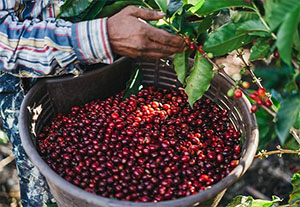 In the late 1900's countries began taking different approaches to the coffee business. Brazil and Vietnam continued to be the biggest producers, both being based on the "Robusta" variety of bean. Other countries, such as Costa Rica refocused their efforts towards high-quality, more specialized production. In 1989 Costa Rica passed a law limiting commercial production to the "Arabica" variety of coffee, a bean widely thought of as superior for flavor and the historically original coffee from Ethiopia.
In the late 1900's countries began taking different approaches to the coffee business. Brazil and Vietnam continued to be the biggest producers, both being based on the "Robusta" variety of bean. Other countries, such as Costa Rica refocused their efforts towards high-quality, more specialized production. In 1989 Costa Rica passed a law limiting commercial production to the "Arabica" variety of coffee, a bean widely thought of as superior for flavor and the historically original coffee from Ethiopia.
Recently, Cafe Britt, one of our local producers listed five reasons why Costa Rican coffee is superior:
Bully! While your up, GG will have another cup of Terrazu dark-roast please....
P.S. Useless Information Department: As of July 15, 2020 the only canton (county) in Costa Rica that had not reported one case of COVID-19 was the Canton of Dota, a strong coffee producing region. Yeah baby, it's in the coffee.
________
Here's an index of previous Chronicles' scribblings on coffee.
Edition 43 March 2012: Coffee Versus Type II
Edition 82 June 2015: Coffee as Health Food
Edition 92 April 2016: Coffee Talk
Edition 97 September 2016: On Being a Catador
Edition 109: September 2017: Coffee Studies Again Positive
Edition 122: October 2018: Health Foods: Red Wine, Coffee, Chocolate
Edition 143: July 2020: The Coffee Story: Part 1 - The History of Coffee
Next month: Part 3 - The Perfect Cup
¡Pura Café!
| Note: The information given in this section is offered as news information only and does not indicate GGC confirmation or denial of the accuracy of the treatment or a recommendation to pursue it, nor can we or do we guarantee the efficacy of the results nor validity of the conclusions proffered. (How's that for a disclaimer amigos?) |
The Spike and Top 7 Infected Zones in Costa Rica
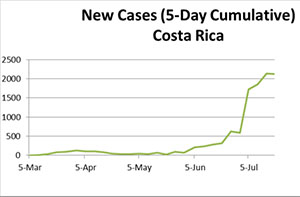 Watching the stats on new cases of COVEI-19 here, it was easy to come to the conclusion around the end of April that we had gone a long way to beating the disease. On the last day of May the number of confirmed cases of COVID-19 in Costa Rica reached the 1,000 mark for the first time.
Watching the stats on new cases of COVEI-19 here, it was easy to come to the conclusion around the end of April that we had gone a long way to beating the disease. On the last day of May the number of confirmed cases of COVID-19 in Costa Rica reached the 1,000 mark for the first time.
Beginning the first week in June we began experiencing an up-tick in cases creating a major spike. By July 30 total experienced cases reached nearly 17,000 causing a reversion from Phase III to Phase II quarantine actions across the country. (See chart above) Instead of plotting each day I have used the cumulative cases in rolling five-day periods (same data as daily numbers but summed for every five days). The last five day period of July shows a down-tick but it's too early to tell if this will be a trend (more next month).
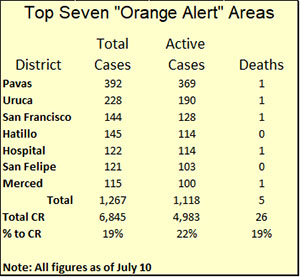 It wasn't long before it became readily apparent that much of the up-tick occurred in four northern border cantons and quickly spread to the denser population areas of the GAM (Grande Area Metropolitano or Greater San José Metropolitan Area). On July 10 the Health Ministry released the list to the left of the top seven problem areas under "orange alert":
It wasn't long before it became readily apparent that much of the up-tick occurred in four northern border cantons and quickly spread to the denser population areas of the GAM (Grande Area Metropolitano or Greater San José Metropolitan Area). On July 10 the Health Ministry released the list to the left of the top seven problem areas under "orange alert":
It's easy to see that the GAM areas are taking the brunt of new infections. The district of Pavas, on the western side of San José downtown is now considered the new "epicenter" of the infection. GGC will be following this process.
Ford Medical Endorsement for HCQ (Hydroxychloroquine)
The Chronicles has noted in recent editions about the relative success Costa Rican protocols have had for treatment of COVID-19 as measured by low death rates (still less than 1% of cases). Last month we said: "One of the differences in treatment here is the early use of Hydroxychloroquine as soon as a patient tests positive. Evidently early treatment prevents the virus from developing to its more serious stages (sounds to me like that's a good explanation for the low death rate here)."
 Less than two weeks after that guesstimate, I received information from a friend who showed me a newly released report by the Henry Ford Health System. HFHS is a major health provider throughout Michigan with 8 hospitals, 29 medical centers, specialized medical facilities and some 1,200 physicians in more than 40 specialties.
Less than two weeks after that guesstimate, I received information from a friend who showed me a newly released report by the Henry Ford Health System. HFHS is a major health provider throughout Michigan with 8 hospitals, 29 medical centers, specialized medical facilities and some 1,200 physicians in more than 40 specialties.
The report concluded, based on a study of 2,541 seriously infected patients, that the use of Hydroxychloroquine, without companion medications like Azithromycin, can reduce the death rate from COVID-19 by almost half (from 26.4% to 13.5%). Even more impressive, the average age of the subjects in that study was 64 with 51% male and 56% African-American.
The current death rate (deaths to cases ratio, all ages) from COVID-19 as of July 30 in Costa Rica is 0.8% versus the U.S. at 3.4%, Panama - 2.2%, Ecuador - 6.7%, Canada - 7.7%, Spain - 8.6% and Italy - 14.2%. On a population adjusted basis the results are just as impressive. To read about the HCQ study go HERE.
Seems we've found at least one treatment helper; now let's bring on the vaccine!
Another Early Treatment Drug
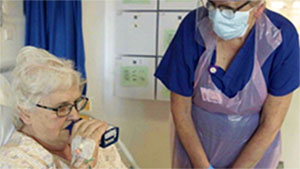 |
|---|
| Inteferon Beta Patient |
Hot on the heels of the Ford Medical announcement about Hydroxychloroquine came a new report of a successful preliminary (my emphasis) trial of 101 volunteer hospital patients where the seriousness and need of intensive care after treatment with the drug was reduced by 79%.
Also, breathing was "very significantly" improved to the extent of not requiring a ventilator and the length of hospital stays were reduced by a third.
The drug, SNG001, also known as Inteferon Beta is a known protein that is introduced directly to the lungs by nebulization. The drug is also used to fight multiple sclerosis.
Come on folks we're getting closer and closer, let's beat this damned virus!
Yet Another Early Treatment Drug
 |
|---|
| Clodomiro Institute |
The Clodomiro Institute at the University of Costa Rica has also recently come up with a new drug that "neutralizes" the Corona virus. Although its not a cure, like that which would come from a vaccine, the drug inhibits the progress of the virus in infected people from becoming more severe thereby lessening recovery time.
The drug was tested at George Mason University in Virginia where its efficacy was confirmed. This drug is produced from the action of horse antibodies on the virus and is extracted from the horses without causing them any harm.
The next phase will be clinical testing in Costa Rica.
¡Pura Vida!
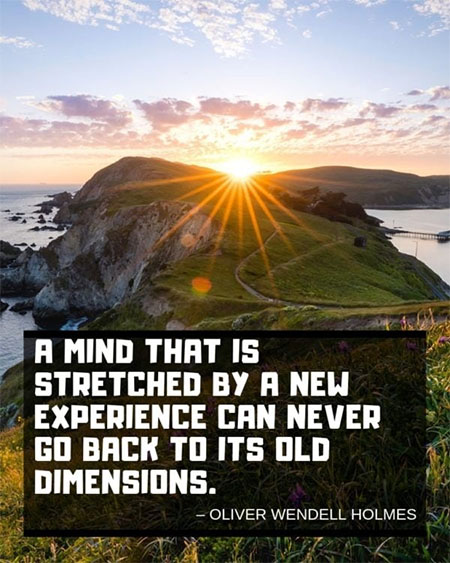
¡A Cachete!
The latest book to hit the market is a new book by Robert A. Normand (aka GG, and yes, this is a plug) entitled Las Esferas, Mystery Spheres of Costa Rica. Check out the cover on the list below and click on the "Read More" button to review a synopsis of the work and to order.

GGC Publications is the parent organization that publishes the Golden Gringo Chronicles as well as a number of books and paraphernalia related to the Chronicles and Costa Rica. The GGC Bookshelf also includes works from a number of other authors that belong to various writers groups based in Costa Rica including the Quepos-Manuel Antonio Writers Group.
Here are the books currently on our bookshelf:
 |
 |
 |
 |
| Las Esferas - English | Mariposa - Español | Mariposa - English | The Chronicles as Narrative |
| Read More | Leer más aquí | Read More | Read More |
 |
 |
 |
 |
| Small Business Guide | Making Time Count | Spiritual Love Connection | Murder or Suicide? |
| Read More | Read More | Read More | Read More |
 |
 |
 |
 |
| Getting Around the Capital | Retiring in Costa Rica | Investigate Living Abroad | What's the Sleuth Up To? |
| Read More | Read More | Read More | Read More |
|
 |
 |
There's Room for More on the GGC Bookshelf Keep Writing Amigos! |
| Casa de Doloros | Overcoming Alcohol | World War II True Story | |
| Read More | Read More | Read More |
All of the above books are available on Amazon.com and the "Read More" links above will lead you to them. You can find more detail on all of them on our GGC Publications Page.
GGC Publications also offers some accessories and paraphernalia related to the Chronicles and with Costa Rican themes, to wit:
T-Shirts:

a. Golden Gringo Chronicles with Logo,
b. Official Golden Gringo with Monkey on Banana Hammock,
c. ¡Quepo en Quepos! ("I Fit In Quepos!") with Photo of Quepos,
d. Wanna Monkey Around? - Come on Down! (shown) with Photo of White Faced Monkey,
e. It's OK to be Slothful with photo of Three-Toed Sloth.
The t-shirts are available in several themes, colors, styles and sizes. See them all HERE.
Coffee Mugs:
a. Golden Gringo, b. Wanna Monkey Around?, c. It's OK to be Slothful
What's life without a great cup of Costa Rican coffee? And it tastes even better in a Golden Gringo Chronicles mug!
To see ALL the products available in the Golden Gringo Store go here: GGC Store.
Answer to Que Es Eso?
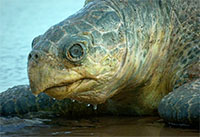 The other turtles might think this is a normal turtle but it really is a robot turtle called "Spy Turtle". Her eyes are cameras and she can record the nesting behavior of her fellow real turtles as well as what happens in water. These new uses for robotics are providing great reams of practical data to environmentalists and others.
The other turtles might think this is a normal turtle but it really is a robot turtle called "Spy Turtle". Her eyes are cameras and she can record the nesting behavior of her fellow real turtles as well as what happens in water. These new uses for robotics are providing great reams of practical data to environmentalists and others.
Would you believe the robot camera turtle lays camera eggs? Yup, check it out here: https://www.youtube.com/watch?v=FqP8slEM9vg&feature=youtu.be.
Arabica versus Robusta
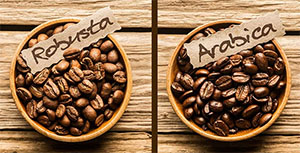 The two major types of coffee bean grown in the world were pointed out in the article above on the business of coffee. The two varieties that account for the vast majority of the beans produced are Arabica and Robusta sharing the market on a 60/40 basis by measure of sales volume.
The two major types of coffee bean grown in the world were pointed out in the article above on the business of coffee. The two varieties that account for the vast majority of the beans produced are Arabica and Robusta sharing the market on a 60/40 basis by measure of sales volume.
One of the important ingredients in coffee that is believed to be helpful to maintain good health is the level of antioxidants. Robusta wins this one as the amount of Chlorogenic Acid, a type of anti-inflammation and antibacterial compound, is 7-10% in Robusta versus 5-8% in Arabica. For other characteristics: caffeine - Robusta 2.7%, Arabica - 1.5% (too much caffeine makes the taste more bitter); lipids & sugars - about 60% more in Arabica vs Robusta (also makes the coffee taste less bitter); Robusta is cheaper by 50% because it is easier to tend on the farm, has a higher yield and is less sensitive to insects as well as likely to be machine harvested whereas Arabica is usually hand picked.
Viva Arabica!
¡Pura Vida!
Gabriella's, Quepos Marina
 Location: Marina Pez Vela, Main Building, Top Floor
Location: Marina Pez Vela, Main Building, Top Floor
Hours: Normally11 AM to 10 PM daily (but check before going as they may be having more limited hours due to the pandemic)
Parking: Plentiful in the main marina parking garage.
Contacts: Tel.: 2774-9000; Email: N/A; Website:
https://gabriellassteakhouse.com/
Reviewing ROMEOS: Glenn N., Bob N.
To Review Our Rating System Go Here: R.O.M.E.O. Rating System
In the midst of the pandemic the ROMEO group has been limited to two or three attendees for our dinners; in this case it was two. Gabriella's was first reviewed in September of 2015 and that review can be seen HERE.
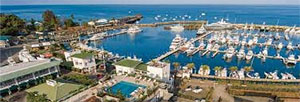 |
|---|
The restaurant has not changed significantly in that it still has a modern, clean look with the chief ambiance attraction being the view from the top floor of the building overlooking what GG would guesstimate as several hundred million dollars worth of boats. Of course there is also the magnificent Pacific Ocean and Coast running north towards Jacó. A pleasant, gentle sea breeze made our latest visit tropical. The composite score for ambiance came in at 5.0/5.0 sloths, the highest score possible from our system.
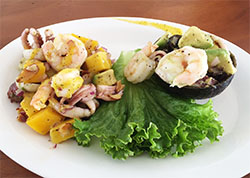 |
|---|
| Passion Ceviche |
The menu contains a wide variety of appetizers and entrées including various forms of fish and other seafood, as well as steaks and pastas.
My co-romeo suggested we try their special ceviche called Passion Ceviche (he was beginning to give away how well he new this restaurant). He ordered a big bowl of it as an appetizer for the two of us. It contained pieces of mango, passion fruit and other tropical fruits in a fruit sauce with pieces of shrimp, pulpo (squid) and fish. Outstanding!
Admittedly, it was the best ceviche GG has had anywhere in Costa Rica so far and I'm not sure how it could be bested.
The restaurant bills itself as a house of seafood, steak and pasta and the menu is replete with selections in all three areas. We started with the ceviche and my dining partner went on to a steak he described as "perfectly cooked", tender and tasty.
GG chose the pasta with shrimp and pieces of mildly spiced Italian sausage in a cream sauce, accented with freshly grated Parmesan. That also was outstanding. The amounts in all the dishes experienced were quite adequate, maybe a little much for lunch. We were both satiated enough to pass on dessert (if you go to the website and check out their desserts you'll see why that was a prudent decision).
Our score for food quality came in at 5.0/5.0, again a perfect score. |
 |
|---|---|
| $$$$ | |
Value Index= 121 |
We were served by a young man who was exceptionally polite, knowledgeable and helpful. GG knocked a point off the service score because it took a considerable amount of time (nearly one hour) to get the main course in a not-so-crowded restaurant. On the other hand one could argue that good food, well prepared, takes time. Our composite score for service came in at 4.5/5.0. That yielded a composite score for ambiance, food quality and service at 4.8/5.0.
My dining partner surprised me at the beginning of the dinner when he boldly asked for the "old menu" which he suggested included a 30% discount. After a short discussion the server produced the old menu and confirmed the discount. Then I learned that my partner and his men's church group meets there for breakfast once a week so the staff there knew him well. I'm not sure whether they would honor a similar request for the "old menu with discount" from a complete stranger but it's probably worth a try.
Our composite score for cost came in at 4.0/5.0 which yields a value index of 4.83/4.0 = 121 and puts the restaurant in the top one third of value ratings of restaurants the ROMEOs have visited. (Note: the Value Index on our previous visit in 2015 was 100 simply because we did not have the discount we enjoyed this time).
The ROMEO group can recommend Gabriella's for excellent food in a pleasant atmosphere at a price to be negotiated! (Maybe the slow times during the Pandemic will help that)
¡Solo Bueno!
The Golden Gringo Chronicles is a free newsletter that is non-political, non-commercial and, hopefully, informative and entertaining. By signing up you will receive an email each month around the first of the month giving you the links to the latest edition as well as to each individual feature and departmental section.
CLICK HERE TO SIGN-UP FOR THE GOLDEN GRINGO CHRONICLES
or Email me at gg@goldengringo.com, or use our Website at: www.goldengringo.com

To Contact GGC World Headquarters (yuk, yuk) to makecomments, suggest topics or criticize my bad jokes, just send an email to: gg@goldengringo.com.
Be pithy but kind; I'm sensitive.
Unsubscribe from the Golden Gringo Chronicles